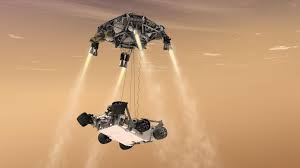Touchdown! NASA’s Perseverance Rover Lands on Mars with Xilinx FPGAs On Board
02-22-2021 04:52 PM

Hello MARS...Congratulations to the amazing engineers and scientists at NASA and Jet Propulsion Labs (JPL) for a successful touchdown on the Mars Jezero Crater on February 18, 2021! We are so proud to be part of this mission with Xilinx FPGAs in the lander rover and instruments, including the vision processor to perform image processing optimization for the historic first images.
In July 2020, NASA launched the Perseverance rover mission, which sought signs of habitable conditions, search for biosignatures, and collect samples for future Mars-sample-return missions and human expeditions and now 7 months later, Perseverance has landed successfully in the Jezero Crater.
The Perseverance rover includes an FPGA-based hardware accelerator in its Vision Compute Element (VCE) that will aid in landing navigation and autonomous driving on the Martian surface. Our Radiation-Hardened Virtex-5QVs (SIRF) serve as the reprogrammable visual processor in the Computer Vision Accelerator Card (CVAC) used to accelerate certain stereo and visual tasks like image rectification, filtering, detection, and matching. Also included on some of the instruments are the Mastcam-Z, a multispectral stereoscopic imaging instrument, which uses a radiation-tolerant Virtex-II FPGA (XQR2V3000) in the digital box based on the Mars Science Lab (MSL) architecture, and the Scanning Habitable Environments with Raman & Luminescence for Organics and Chemicals (SHERLOC) spectrometer, which uses the MAHLI with a camera system incorporating the XQR2V3000 FPGAs.

Figure 1: Perseverance Rover (Source: NASA)

Figure 2: Vision Compute Element (Source: EEJournal).
This is not Xilinx’s first mission to Mars. NASA’s Opportunity Rover Mission came to an end on February 13, 2019, after exploring the surface of Mars for 15 earth years, even though the design was intended to last just 90 Martian days. NASA’s Mars Exploration Program is one of the most successful interplanetary exploration missions ever. We congratulate the team at JPL and thank them for making Xilinx part of these historic missions.
What’s in the Past?

Figure 3: MER Opportunity (Source: NASA)
NASA’s Mars Exploration Rover (MER) mission involved two Mars rovers: “Spirit” and “Opportunity.” They were designed to explore the planet for water sources on Mars. Planned to last 90 days, the rovers exceeded everyone’s expectations with Spirit lasting 7+ years (20X longer) and Opportunity lasting 15 years (55X longer)—both returning valuable information about the geological composition of the planet!
In creating these incredible MERs, designed to run on solar power, the JPL team used radiation-tolerant Xilinx® Virtex®-4 FPGAs, state-of-the-art in FPGA space-grade technology at the time of the design, for both the landing and on-surface operation of the Mars rovers. Specifically, XQVR4062 FPGAs went into each MER landing craft to control the crucial pyrotechnic operations during a rover’s multiphase descent and landing procedure, when the engineers trigger explosives for various stages of the maneuver. NASA engineers used the FPGAs at the heart of the Lander Pyro Switch Interface system, which orchestrated the MERs’ elaborate pyrotechnic sequence to the millisecond. In addition, NASA also used XQVR1000s in the MER Motor Control Board, which oversees the motors for the wheels, steering, arms, cameras, and various instrumentation, enabling the rovers to travel about the planet’s often silt-like surface and negotiate various obstacles.

Figure 4: MSL Curiosity (Source: NASA)
The next rover to travel to Mars, the Mars Science Lab (MSL), aka “Curiosity,” was launched in 2011 and traveled for eight months on a 352-million-mile journey. Designed to run on nuclear power, it is still navigating the Martian surface, trying to ascertain whether the planet ever supported microbial lifeform. Initially designed for a 2-year mission, the rover is still operational and going strong 8+ years later and will likely continue to do so for years to come.
Xilinx space-grade products enable key instrument systems like MAHLI (imager), ChemCam (remote sensing instruments), Electra-Lite (communications), and MALIN (processor) on the rover. Mars Hand Lens Imager (MAHLI), a camera on the rover’s robotic arm, acquires images, while the MALIN system consists of backend image processing boxes that process images from all onboard cameras. Xilinx’s Virtex®-II (XQR2V3000) Radiation Tolerant FPGAs implements the image pipelines in these systems. All interface, compression, and timing functions are implemented as logic peripherals of a MicroBlaze™ soft-processor core in the Virtex-II FPGA. This enables the Curiosity to send back stunning images of an alien landscape that is 35 million miles away. ChemCam (Chemistry and Camera Complex) provides elemental compositions and high-resolution images of rock and soil using Xilinx’s radiation-tolerant XQ2V1000 FPGA.
Curiosity is equipped with significant telecommunications systems like the X Band transmitter and receiver that can communicate with Earth and a UHF Electra-Lite software-defined radio for communicating with Mars’ orbiters that serve as the primary path for data return to Earth. Xilinx’s XQR2V3000 radiation-tolerant FPGAs serve in these communication boxes, providing critical links back to Earth.
Xilinx gives our customers a license to architect an adaptable future, are YOU ready for future missions and scientific pursuits? To learn about Xilinx space solutions, visit https://www.xilinx.com/applications/aerospace-and-defense.html